Content
Published:
This is an archived release.
Eight in ten hike in the woods or the mountains
Norwegians are active in the outdoors, and we use the forests and mountains for both hiking and skiing. However, we are not as active in fishing, hunting, and berry or mushroom picking as before. Eight out of ten Norwegians went hiking in the woods and in the mountains, and four out of ten have been on short skiing trips. As in 2011, persons with a higher education have been the most active in outdoor activities in 2014.
| 2011 | 2014 | |
|---|---|---|
| On a shorter trip for hikes in the forest or in the mountains | 81 | 79 |
| On a shorter trip skiing in the forest or in the mountains | 42 | 39 |
| On berry-picking or mushroom-picking | 37 | 34 |
| On fishing trip | 45 | 43 |
| 2007 | 2013 | |
| Jogging | 38 | 40 |
| Biking | 40 | 45 |
| Strength training | 30 | 39 |
| Exercise or train at least once a week | 73 | 82 |
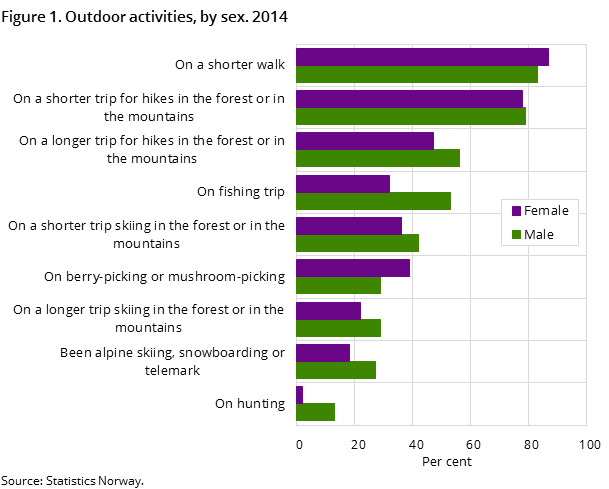
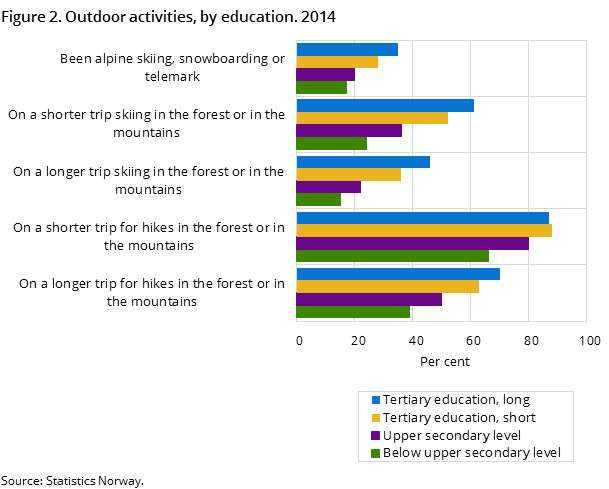
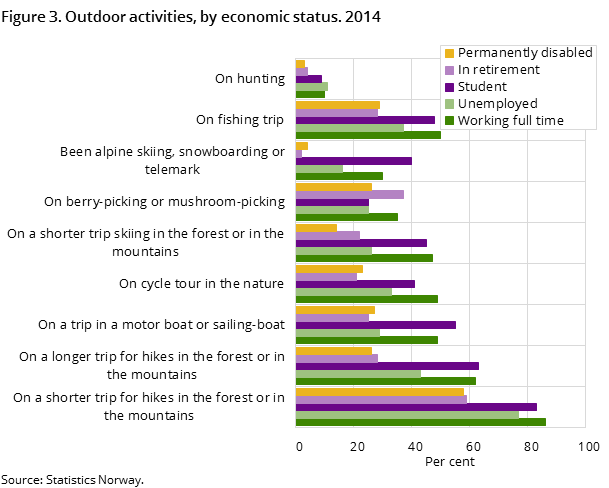
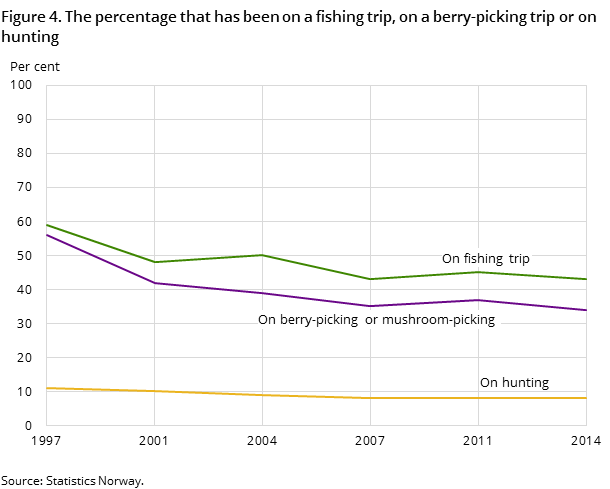
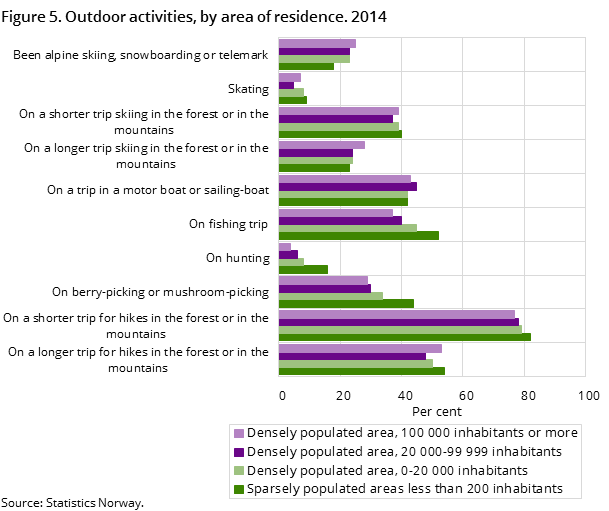
The Survey of Living Conditions EU-SILC 2014 examines outdoor activities within the Norwegian population. As in previous years, the population is active in outdoor activities. The most popular outdoor activities in the period 2004-2014 are short walks and short hikes in the woods and mountains. Eighty-five per cent of the population aged 16 and above report that they have been on a short walk, and 80 per cent have been on a short hike in the woods or in the mountains. Half of the population has been on long hikes in the past 12 months. Norwegians also enjoy skiing. Thirty-nine per cent report that they went on a short skiing trip in the woods or in the mountains, and 25 per cent have gone on a long skiing trip.
Gender differences
Men are more active in relation to skiing trips, long walks and alpine skiing than women (see Figure 1). Fifty-six per cent of men went on a long hike in the woods or in the mountains during a twelve-month period. Similarly, this applies to 47 per cent of women. Men are also more active in fishing and hunting, but the differences are smaller compared to previous years. Outdoor activities such as mushroom and berry picking, riding in the natural surroundings and short walks, however, are more prevalent among women than among men.
The elderly prefer berry or mushroom picking, whilst the youngest go alpine skiing
As in 2011, the activity level is lower for the older population than the younger within most of the mapped outdoor activities. Eighty-five per cent of people aged 25-44 years during the last 12 months have been on a short hike in the woods or in the mountains. For people aged 67 and above the corresponding share is 56 per cent. However, as in 2011, more of the elderly population has been on berry or mushroom picking than the younger population. As in previous years, the largest proportion going snowboarding or alpine skiing is found among the youngest age group. A total of four out of ten aged 16-24 have gone snowboarding or alpine skiing during the year. By comparison, this applies to two out of ten in the general population.
Couples are more active than single persons
Comparing different family phases; couples have been more active in the various activities that we have surveyed. Being in a relationship is particularly significant to the activity level among people 67 years and above. Thirty-one per cent of couples – double the share of single persons - in this age group reported that they had been on a long hike in the woods or in the mountains during the year. Couples with children aged 7-19 years are the most active on both short and long skiing trips in the woods and in the mountains. Fifty-seven per cent report that they have been on a short skiing trip during a twelve-month period. Also in relation to families with children, being part of a couple increases the activity level. Couples with children are more actively skiing and skating than single parents.
Employed persons and those with a higher education are most active
As in 2011, the degree of activity for most of the mapped outdoor activities increased with educational level. As shown in Figure 2, the proportion that has been on both short and long skiing trips during the year increases with the level of education. Sixty-one per cent of those with a long tertiary education have gone on a short skiing trip. The share among the population with a lower secondary education is 24 per cent. Long hikes in the forest or in the mountains are also a more common form of activity among those with a higher education. There is also a higher proportion that has been alpine skiing or snowboarding among persons with a higher education. There are no differences based on education when we look at activities such as hunting, fishing and riding.
Comparing groups with different self-defined economic status, we find that employed persons and students are generally more active than the unemployed, the disabled and pensioners (see Figure 3). The differences are greatest in outdoor activities such as long hikes, skiing, alpine skiing and boat trips. The difference is apparent in the context of differences in age and health. Six out of ten employed persons and students have been on a long hike during a twelve-month period. Similarly, this applies to four out of ten of the unemployed and nearly three out of ten pensioners and disabled. Hunting trips are the only outdoor activity where the unemployed are equally active as employed persons. Pensioners, however, are equally active in berry or mushroom picking as employed persons.
Fishing and berry or mushroom picking most popular in rural areas
As shown in Figure 4, there has been a decline in the proportion of the population who have been on a fishing trip and berry or mushroom picking in the period 1997-2014. Fifty-nine per cent of the population aged 16 years and above went on a fishing trip during a period of twelve months in 1997. The corresponding figure for 2014 is 43 per cent. The proportion who report having been on berry or mushroom picking has decreased by 22 percentage points during the same period.
The greatest proportion that have been on fishing trips and been berry or mushroom picking (see Figure 5) is found in rural areas. Half of all of those who live in the most sparsely populated areas have been on a fishing trip during the year. In the more densely populated areas, 40 per cent of the population went on a fishing trip during the year. Persons in rural areas also go berry or mushroom picking more often than persons living in more densely populated areas. Unlike most other outdoor activities, there is a slightly higher percentage that have been on long skiing trips and alpine skiing or snowboarding among those who live in the most densely populated areas.
Break in series in measurement of outdoor activitiesOpen and readClose
Since 2011, some outdoor activities have been deleted and some of the questions have changed slightly compared to the years 1997-2007. First and foremost, the duration of some activities has changed. Earlier we distinguished between day and overnight trips, now we distinguish between short and long trips (over/under 3 hours). In addition to this, the collection method has changed. Previously, this data was obtained via the post, but since 2011 the survey data has been collected via telephone interviews (CATI).
The categories that can be compared with the previous surveys of living conditions are:
- Been berry or mushroom picking last 12 months
- Been on a hunting trip last 12 months
- Been fishing the last 12 months
- Been horseback riding in a natural setting
- Been skating last 12 months
- Been alpine skiing, snowboarding or Telemark skiing last 12 months
- Bathed in salt or fresh water the last 12 months
- On a short walk the last 12 months
Find more figures
Find detailed figures for Sports and outdoor activities, survey on living conditions
Contact
-
Håvard Bergesen Dalen
E-mail: havard.dalen@ssb.no
tel.: (+47) 40 90 23 50
